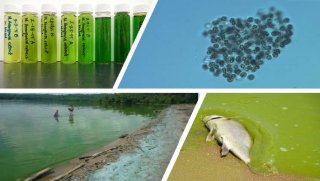Harmful Algal Blooms Research
- Health Effects and Toxicity
- Managing Harmful Algal Blooms in the Built and Natural Environment
- Harmful Cyanobacterial Bloom Forecasting
- Additional Resources

Most freshwater aquatic microorganisms are not harmful, but sometimes certain types of these organisms can grow in excessive amounts, forming blooms with the potential to negatively affect human health, animal health, and economic activity. Commonly called harmful algal blooms (HABs), these visible masses of microorganisms include algae and cyanobacteria Cyanobacteria are a group of cyan colored bacteria often referred to as blue-green algae. Cyanobacteria, are frequently found in freshwater systems. They can also be found in estuarine and marine waters in the U.S. Cyanobacteria are often confused with green algae, because both can produce dense mats that can impede activities like swimming and fishing, and may cause odor problems and oxygen depletion; however, unlike cyanobacteria, green algae are not generally thought to produce toxins. Some freshwater cyanobacterial blooms or cyanoHABs are able to produce highly potent toxins, known as cyanotoxins. that are capable of producing toxins and other irritants. Cyanobacteria, a type of bacteria capable of photosynthesis The process that plants use to convert sunlight to energy to live and grow., have the potential to produce toxins, the most common of which in the U.S. are microcystins, cylindrospermopsins, anatoxins, and saxitoxins.
HABs result from complex ecological processes that are affected by a variety of factors including nutrient and light availability, water temperature, weather patterns, lake or water body characteristics, and competing microorganisms. HABs have been observed in all 50 states. Potential impacts from exposure to HABs and associated toxins include health risks to humans, pets, livestock, wildlife, and other biota; restricted recreational activities; damaged ecological systems; increased water treatment costs; and decreased economic revenue.
EPA’s research focuses on ways to eliminate or reduce the negative effects of HABs on human health and the environment through research on monitoring and treatment of HABs and the assessment of adverse health outcomes from exposure to HABs.
For more information about HABs, please visit EPA’s webpage on HABs in water bodies.
Health Effects and Toxicity
There is a pressing need to develop data, methods, and tools to advance the understanding of adverse health impacts of cyanobacteria and cyanotoxins, especially those emerging cyanotoxins among people, other animals and plants that are associated with exposure to HABs from both planktonic and benthic cyanobacteria. EPA researchers are characterizing and estimating the adverse health effects of cyanobacteria and cyanotoxins on animals and humans using multiple toxicity models and epidemiological investigations.
Research Focus
- Examining the specific effects and adverse outcomes of cyanobacteria and cyanotoxin exposure on both wildlife and domestic animals.
- Characterizing human health effects associated with recreational and occupational exposure to cyanobacteria and cyanotoxins.
- Developing methods to measure toxins in various materials at low concentrations.
- Characterizing basic properties of planktonic (living in the water column) and benthic Bottom-dwelling. Benthic organisms spend at least part of their lives in, on or near the bottom of aquatic environments. cyanobacteria and associated toxins related to adverse health outcomes.
Related Resources
Managing Harmful Algal Blooms in the Built and Natural Environment
HABs can produce toxins with documented health effects, produce unpleasant and potentially dangerous tastes and odors from the source to the drinking water tap, and are visually unappealing. People can be exposed to HABs through water-based recreation (swimming, boating, or fishing) and through the ingestion of contaminated drinking water. The presence of tastes and odors in contaminated drinking water can economically affect the local water utility due to treatment costs and loss of customer confidence. The unpleasant visual impact of HABs can lead to loss of use in recreational areas and potential economic harm to the surrounding community. While HABs impact communities across the country, they may disproportionately affect low-income communities who may not have options in choosing the source of their drinking water (e.g., buying bottled water during contamination events), where they live, and selecting alternative recreational locations.
EPA researchers seek to identify vulnerable public drinking water systems as well as effective HAB interventions and treatments for surface and drinking waters.
Research Focus
- Developing a rigorous framework for identifying water sources and drinking water systems vulnerable to HABs.
- Evaluating the efficacy and impacts of chemical and physical HAB interventions applied to source waters.
- Evaluating the efficacy and impacts of interventions applied to remove cyanobacterial biomass and metabolites from drinking water.
Related Resources
- Harmful Algal Blooms Mitigation and Treatment Research
- Harmful Algal Blooms and Drinking Water Treatment
- Source Water Quality Research
Harmful Cyanobacterial Bloom Forecasting
Providing advanced notice tools to water quality managers and environmental practitioners helps them respond more quickly and efficiently to HAB events and to better protect human, animal, and ecosystem health. EPA researchers are developing the science required to forecast HAB events in freshwater and estuarine systems, including the use of bioindicators, environmental drivers, and aquatic community structure, comparing multiple forecast models, and linking the ecological factors to human populations and communities.
Research Focus
- Developing models to forecast freshwater HABs across systems.
- Linking HAB formation and impacts to human populations and communities.
Related Resources
- Harmful Algal Blooms Monitoring and Remote Sensing Research
- Cyanobacterial Harmful Algal Blooms Forecasting Research
- Forecasting freshwater cyanobacterial harmful algal blooms for Sentinel-3 satellite resolved U.S. lakes and reservoirs (2024)
- The Harmful Algal Bloom and Hypoxia Research and Control Amendments Act (HABHRCA)
For a comprehensive list of forecasts, please visit EPA’s webpage on Harmful Algal Blooms Forecasts.
Additional Resources

Applications and Tools
- Cyanobacteria Assessment Network Application (CyAN app)
- EPA Science Models and Research Tools (SMaRT) Search
Analytical Methods
- Method 544: Determination of Microcystins and Nodularin in Drinking Water
- Method 545: Determination of Cylindrospermopsin and Anatoxin-a in Drinking Water
- Method 546: Determination of Total Microcystins and Nodularins in Drinking and Ambient Waters
- Method for Determination of Microcystins and Nodularin in Ambient Freshwaters
- Method for Determination of Cylindrospermopsin and Anatoxin-a in Ambient Freshwaters (pdf)
